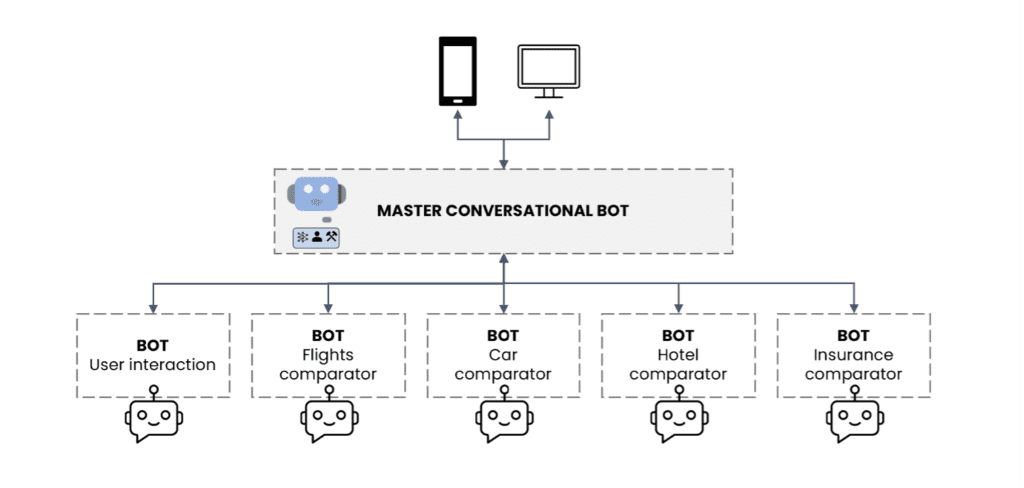How Master Conversational Bot is going to reshape your interactions with machines? – Part 3/3
How will digital architecture enhance the adoption of MCB?
MCB will be a unique chatbot that will integrate with a plethora of small Bots attached to that system of records or third-party applications and, depending on the context, will automatically delegate the request to one or many sub-chat bots via a transparent API call. Those MCBs will have their backend architecture to support the core of the conversation, context and habits. This backend will also handle the governance and behaviour of your MCB. Microsoft started a project in mid-2023 to foster interaction between bots. This project helps with the concept of interface contracts and tackles the current challenges of having bots communicating with each other.
Customers
For personal use, search engines are currently leading the charge. Soon, it will be found in your favourite mobile chat application (Messenger, Whatsapp, WeChat, etc..), and it will become your partner for knowledge, booking your holidays, organising your takeaway, etc… Two factors can explain the shift to chat applications:
- Gen Z and Gen Alpha are native mobile users and are more likely to search via social media than search bars.
- Gen Y and older are less forgiving about search bar wrong results and tend to give up more quickly. The tendency of chat by nature is to exchange till you find what you were looking for in the first place.
Employees
For professional usage, productivity suits (Office and Google Workspace) are currently leading; MCB will be orchestrated as an extension of MS Teams or Google Chat. It will simplify onboarding and day-to-day operations through a unique channel of communication. Like their mobile chat counterpart, they can handle chat discussions, audio, and video, making the MCB a multi-channel assistant.
Three parts will support the underlying architecture of the MCB. First, an LLM will do the conversational orchestration part. Second, an array of Slaves Conversational Bot (in the sense of dependents from the Master Conversational Bot) APIs to deliver autonomous features through specific and segregated data. And lastly, an integration to mobile chat applications (personal or professional).


The imminent rise of Master Conversational Bots embodies a pivotal transformation, promising a convergence of functionalities, coherence in user experience, and efficiency in both personal and professional spheres. As we witness this paradigm shift towards unified and intelligent conversational interfaces, the future seems poised for a seamless and user-centric evolution in how we interact with technology.
Conclusion
The spread and adoption of Conversational bots is expected to accelerate thanks to two levers: improving the User Experience (UX) and building seamless access to various services through a unified interface. A performant UX Design will be crucial to support the behavioural changes by enhancing the quality and empathy of the user-bot interactions. Also, the accessibility and simplicity of usage will be boosted by a solid Technical Architecture shared by the main actors of the sector.
Hopefully, by the end of 2024, users will be able to open their usual communication platform to access products and services, as information will be delivered to them instead of requiring active searching.


Adrien
Adrien joined onepoint in 2019 and currently serves as the Chief Technology Officer (CTO) for the Asia-Pacific region.

